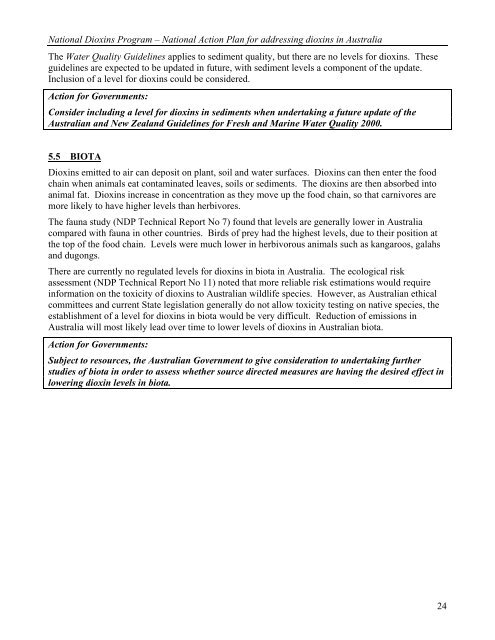National Action Plan for Addressing Dioxins in Australia
National Action Plan for Addressing Dioxins in Australia
National Action Plan for Addressing Dioxins in Australia
- No tags were found...
You also want an ePaper? Increase the reach of your titles
YUMPU automatically turns print PDFs into web optimized ePapers that Google loves.
<strong>National</strong> <strong>Diox<strong>in</strong>s</strong> Program – <strong>National</strong> <strong>Action</strong> <strong>Plan</strong> <strong>for</strong> address<strong>in</strong>g diox<strong>in</strong>s <strong>in</strong> <strong>Australia</strong>The Water Quality Guidel<strong>in</strong>es applies to sediment quality, but there are no levels <strong>for</strong> diox<strong>in</strong>s. Theseguidel<strong>in</strong>es are expected to be updated <strong>in</strong> future, with sediment levels a component of the update.Inclusion of a level <strong>for</strong> diox<strong>in</strong>s could be considered.<strong>Action</strong> <strong>for</strong> Governments:Consider <strong>in</strong>clud<strong>in</strong>g a level <strong>for</strong> diox<strong>in</strong>s <strong>in</strong> sediments when undertak<strong>in</strong>g a future update of the<strong>Australia</strong>n and New Zealand Guidel<strong>in</strong>es <strong>for</strong> Fresh and Mar<strong>in</strong>e Water Quality 2000.5.5 BIOTA<strong>Diox<strong>in</strong>s</strong> emitted to air can deposit on plant, soil and water surfaces. <strong>Diox<strong>in</strong>s</strong> can then enter the foodcha<strong>in</strong> when animals eat contam<strong>in</strong>ated leaves, soils or sediments. The diox<strong>in</strong>s are then absorbed <strong>in</strong>toanimal fat. <strong>Diox<strong>in</strong>s</strong> <strong>in</strong>crease <strong>in</strong> concentration as they move up the food cha<strong>in</strong>, so that carnivores aremore likely to have higher levels than herbivores.The fauna study (NDP Technical Report No 7) found that levels are generally lower <strong>in</strong> <strong>Australia</strong>compared with fauna <strong>in</strong> other countries. Birds of prey had the highest levels, due to their position atthe top of the food cha<strong>in</strong>. Levels were much lower <strong>in</strong> herbivorous animals such as kangaroos, galahsand dugongs.There are currently no regulated levels <strong>for</strong> diox<strong>in</strong>s <strong>in</strong> biota <strong>in</strong> <strong>Australia</strong>. The ecological riskassessment (NDP Technical Report No 11) noted that more reliable risk estimations would require<strong>in</strong><strong>for</strong>mation on the toxicity of diox<strong>in</strong>s to <strong>Australia</strong>n wildlife species. However, as <strong>Australia</strong>n ethicalcommittees and current State legislation generally do not allow toxicity test<strong>in</strong>g on native species, theestablishment of a level <strong>for</strong> diox<strong>in</strong>s <strong>in</strong> biota would be very difficult. Reduction of emissions <strong>in</strong><strong>Australia</strong> will most likely lead over time to lower levels of diox<strong>in</strong>s <strong>in</strong> <strong>Australia</strong>n biota.<strong>Action</strong> <strong>for</strong> Governments:Subject to resources, the <strong>Australia</strong>n Government to give consideration to undertak<strong>in</strong>g furtherstudies of biota <strong>in</strong> order to assess whether source directed measures are hav<strong>in</strong>g the desired effect <strong>in</strong>lower<strong>in</strong>g diox<strong>in</strong> levels <strong>in</strong> biota.24
















